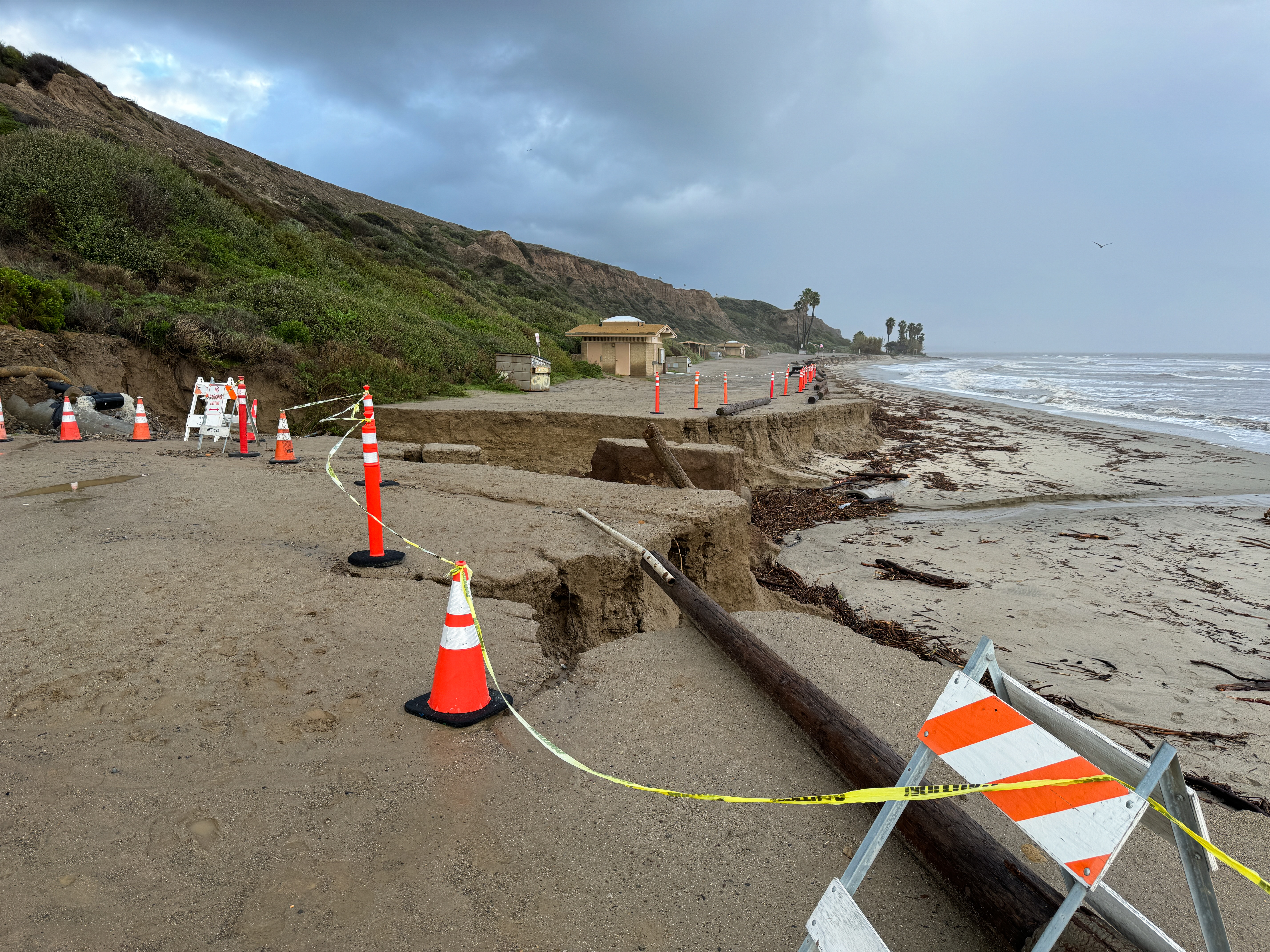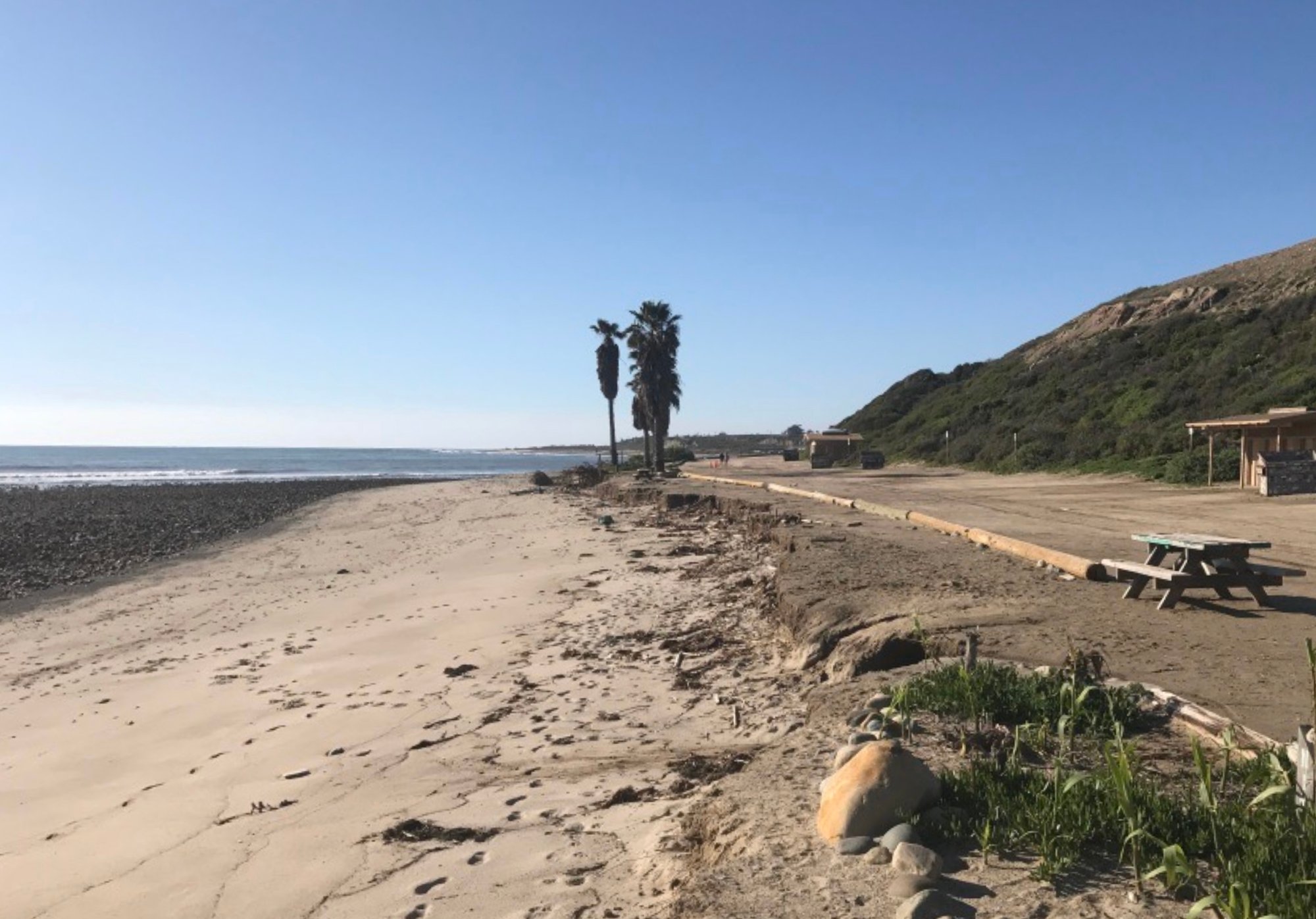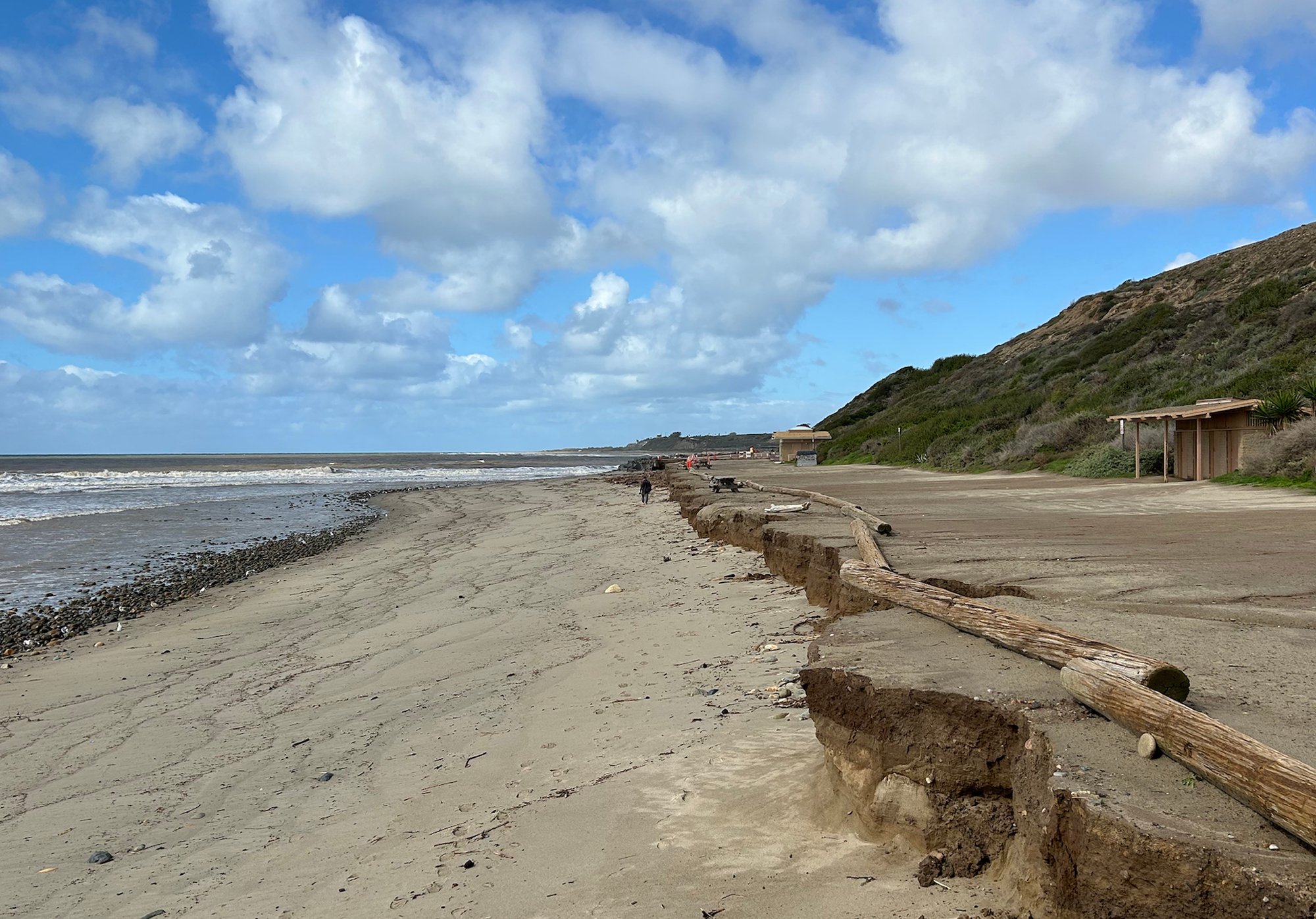
02.08.24
El Niño Slams San Onofre: Surfrider Calls for a Long-Term Plan that Works with Nature
By AlexAccess Update: 4/16/2024
As of Monday, 4/8/2024, San Onofre State Beach is, once again, fully open to vehicle access.
The repairs included backfilling the road’s washed-out segment as well as rerouting the stormwater drainage outflow beneath the road, with the outflow discharging directly onto the beach.
Ocean erosion from the 2023-2024 winter season further narrowed the road south of the repair. This has resulted in a need to alter some segments of parking from pull-in to parallel. Fortunately, this should not greatly impact the number of cars let in from the time before the park closed, as one stretch of road was then completely closed to parking.
While we grab for our boards and celebrate the restored access, Surfrider staff will continue our efforts on long-term resilience planning to ensure reliable access to the beach for generations to come, regardless of weather-related erosion events.
Access Update: 3/26/2024
After a month and a half of significant access restrictions at San Onofre State Beach, we’re glad to share that repairs are gearing up and the restoration of vehicle access is anticipated as soon as the first week of April.
Camp Pendelton has issued a notice that repairs began Monday, 3/25, and will be concluding roughly within a week.
This repair process has been timed in hopes of avoiding damage to a repaired road from further extreme rain events. As the weather moves in for the coming week, we are also aware that there could be unexpected delays from the original timeline provided by Camp Pendelton.
While this road repair project will address the immediate access issues related to the stormwater runoff damage, on a large scale, coastal erosion remains a chronic concern at San Onofre and throughout Southern California.
At Surfrider, we celebrate restored access while remaining committed to advocating for smart coastal planning that utilizes the power of nature to safeguard our coastlines for future generations.
Continue reading for more information on how we got here, what makes “San O” such a special place, and Surfrider’s long-term vision for this storied stretch of coastline.




Urgent update on access limitations
at San Onofre State Beach
Once again, vehicle access to San Onofre State Beach has been temporarily suspended. Shoreline and bluff erosion have long plagued San Onofre, but extreme weather brought on by this winter's El Niño has only exacerbated the problem.
We at Surfrider are concerned about this access limitation and the damage caused by the combination of coastal erosion and this past week’s rain. We have been monitoring San O closely over the years, with concern surrounding the possibility of road failure.
That said, we are optimistic and see a way forward to a more resilient San Onofre, where people can access the surf regardless of the weather.
FAQ
Q: Is the closure caused by a drain pipe?
A: The most recent erosion issue was largely caused by storm drain outflow that was overwhelmed by heavy rains; however, this particular section of the road has been dramatically narrowing due to erosion over the past three months caused by ocean waves and accelerated by the revetment.
Q: What's a vernal pool, and does it relate to what's happening at San O?
A: The term “vernal pool” is simply the technical name for a specific type of shallow depression that is wet seasonally. At San O, the tabletop between the park entrance and the beach features such formations. It is estimated that more than 90% of California's Vernal Pool habitat has been lost. These vernal pools were human made, built to create a habitat to support endangered fairy shrimp. It is unclear if the vernal pools are related to the erosion at this point.
Q: How long will it take to get open again over the short term?
A: A reopening date has not yet been provided. We are confident that repairing the road is an immediate priority for State Parks and are grateful for their efforts. As soon as a date is provided, we share that update. If you would like to stay informed and receive updates, you can join the list by signing up for updates in the form below.
Q: Who is the decision maker / who is responsible for the shore at San O?
A: San Onofre State Beach is leased from the Marine Corps Base Camp Pendleton by California State Parks. State Parks is tasked with managing the land with the consent of Camp Pendleton.
Q: What's your position on a long-term solution?
A: Surfrider believes there exists a way to restore the beach at San O using nature-based solutions, maintaining access for the public well into the future by working with the natural dynamics of the beach—not against them.
Q: What is a Nature-Based Solution?
A: Learn more at surfrider.org/fighting-climate-change-with-nature
How did we get here?

Surfrider has long advocated for San Onofre State Beach’s well-being. We opposed the emergency permit for a revetment (seawall) at “the Point.” Although it was intended as a protective measure to maintain the road access, we knew the revetment would pose long-term risks to the beach, including accelerated erosion, negative impacts on surf quality due to backwash, and eventual harm to the unique coastal ecosystem. Unfortunately, these concerns have proven to be true.
San Onofre faces a barrage of challenges today, battling not only the relentless coastal erosion but also bluff top erosion and stormwater runoff hammering the access road. Dubbed the "pinch point," this narrow passage is not a new concern and has endured decades of damage and subsequent rebuilding efforts. In 2017, the revetment was installed with an approved five-year period of operation to shield the pinch point.
Since the installation of the revetment, we've seen the beach change remarkably. This year alone, the erosion has migrated past the last remaining transplanted palm tree, stood up in the ‘90s, pushed back palapas, and claimed at least one shower. The last two months have been exceptionally brutal. King tides, large swells, and heavy rainfall have taken their toll on the beach and access road, leaving an unmissable line of scarping carved into the beach south of the revetment.


The local community feels the impacts firsthand, waiting tenuously with high tides flooding and closing the parking lot; and now, we watched helplessly last week as the vulnerability escalated to the Park’s closure of the road. At the same time, the revetment experienced flanking erosion, causing further erosion and narrowing of the road. On the inland side, stormwater, intensified by torrential rain, swiftly carved an impassable trench across the road within the span of just a week.
These compounding forces highlight the delicate nature of accessing the beach at San O and the urgent need for resilient solutions to protect both access and the natural resources of the State Beach.
How do we fix it?
150 miles north, a similar challenge unfolded at Surfers’ Point in Ventura, CA.
In 1989, a poorly planned public space was built on the shoreline, “protected” from the ocean by sea walls and revetment. Within 10 years, the sea had already swallowed the seaward boundary of the parking lot and public bike lanes. Soon, the shore was riddled with rubble as the sand began to vanish, leaving the beach in front of the iconic point break a degraded mess — unusable for beachgoers and unsafe for surfers accessing the break.
Surfrider’s Ventura County Chapter took action, partnering with the City of Ventura, local communities, watershed experts and engineers to spearhead a visionary campaign advocating for the use of nature-based solutions. Countering the call for more hard armoring to fight the ocean, Surfrider proposed and championed the cause for a completely restored beach. This project would include relocating a bike path and parking inland and restoring the space with cobble, dunes, and native vegetation designed to work with natural processes.
The project's first phase, completed in 2011, continues to provide tangible outcomes — showcasing dramatic gains in resilience, restored habitat, and enhanced access. In the years since, Surfers’ Point Living Shoreline has seen extreme storms, swell, and tide events, each time rebounding visibly stronger.

In stark contrast to Surfers’ Point, across the Ventura River, Emma Wood State Beach presents a bleak picture of erosion control. The shoreline riprap and coastal armoring, coupled with this winter’s swells and storms, have drowned the popular beach while the break suffers the effects of wave reflection (backwash). Road access to the State Beach was severely damaged during January’s storms and has been closed ever since.
While Surfers’ Point and San Onofre have differences in their coastal geology and sea floor, we see an opportunity to build upon the lessons learned at Surfers’ Point and to apply a similar approach to San O.
Next Steps for Surfrider
The good news is that during the past few years, Surfrider has been focused on building strong relationships with the community at San Onofre. Surfrider has been meeting regularly with community and agency stakeholders while conducting community outreach on the effects of coastal erosion and the success of nature-based solutions — including a group panel held at the 2023 Ohana Fest on the topic of protecting our local coastline.
With each passing season, the need for a comprehensive solution to mitigate the threat of impaired access from road closures becomes more evident. In the summer of 2023, we began developing a plan for community science shoreline monitoring that would allow members of the public to snap photos on their way to the beach to show precisely where erosion was occurring day to day. Unfortunately, as fall moved in, the various monitoring stations quickly disappeared into the ocean.
Looking forward, Surfrider plans to facilitate larger conversations between the larger community, agencies, and coastal engineers to envision long term solutions for San O. Together, we aim to facilitate conversations with stakeholders to ensure we can continue to access and enjoy San Onofre’s coastal resources, regardless of weather conditions.
What makes “San O” worth saving?
The park's history overflows with stories of shared waves, bonfires, and a unique opportunity for camaraderie that has developed over the decades. This stretch of coast is not merely a surf spot though. The beach and surrounding land have been regarded as a sacred site since time immemorial, known as Panhe to the Indigenous people of the Acjachemen. San Onofre holds profound cultural importance and a uniquely intact coastline, long stewarded by the Acjachemen.
San O is a cherished pocket of the coast, where time feels like it has stood still since the golden days of surfing. Surf historian Matt Warshaw has written, “Every notable surfer in California from the mid-'30s to the early '40s visited San Onofre.”
San Onofre's significance also spans beyond its local impact, playing a pivotal role in the broader narrative of surfing's adoption in the mainland United States. With a direct lineage to its Hawaiʻian roots, San Onofre is a beacon of the sport's cultural heritage, providing pristine waves and nurturing a deep respect for surfing as an art form and a way of life.
The Surfrider Foundation's history is also intricately woven with pivotal moments at San Onofre. At a high level, the Save Trestles campaign stands out as a landmark initiative directly tied to protecting the park. This environmental battle aimed to protect the iconic Trestles surf break and its surroundings from the proposed toll road. Through direct grassroots action by the public, Surfrider played a crucial role in the victory against the toll road project. This was a massive victory for the public that cherishes this special place.
How to Stay Updated
Surfrider is in close contact with California State Parks and local agencies to understand when access to the road will be restored. We are very concerned about current erosion issues up and down the California coast. We are committed to finding equitable and sustainable solutions that ensure healthy and accessible coastlines now and for generations to come.
If you would like to stay informed and receive updates regarding the state of the beach at San Onofre and our efforts there, simply sign up below.
